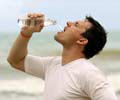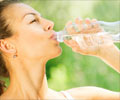It's a hugely beneficial liquid in a slim cylinder of plastic, but for US environmentalists, it is the new public enemy number one: bottled water.
It's a hugely beneficial liquid in a slim cylinder of plastic, but for US environmentalists, it is the new public enemy number one: bottled water.
With US bottled water sales growing nearly 10 percent annually -- and the trash from tossed containers climbing just as quickly -- calls for Americans to go back to drinking tap water have surged since the beginning of summer."This country has some of the best public water supplies in the world," the New York Times said in an editorial earlier this month.
"Instead of consuming four billion gallons (15 billion liters) of water a year in individual-sized bottles, we need to start thinking about what all those bottles are doing to the planet's health."
As was pointed out at World Water Week in Stockholm on Monday, US personal consumption per capita, including water from all sources, hits 400 liters (106 gallons) each day -- compared to 10 liters (2.6 gallons) a person in developing countries.
And US consumers are drinking more bottled water by the day. According to the Beverage Marketing Corporation, growth in bottled water sales last year was 9.7 percent, making the total market worth about 11 billion dollars.
Bottled water in the United States does not mean mineral water, even if Americans grumble more and more about paying a high price to drink water with little to distinguish it.
Advertisement
Pepsi's response "is an important first step," said Gigi Kellett, director of the "Think Outside the Bottle" campaign.
Advertisement
From mineral springs or from public pipes, water once in a bottle is expensive. The New York Times estimated that for some consumers the bill could hit 1,400 dollars a year -- for an amount that, taken from a home faucet, might cost less than half a dollar.
And it is not always better.
"Bottled water sold in the United States is not necessarily cleaner or safer than most tap water, according to a four-year scientific study," the National Resources Defense Council recently reported. It also said regulation has not guaranteed more pure water in bottles.
Another point of attack is the packaging waste, which Earth Policy Institute tied to an issue of US security policy: oil imports.
According to the institute, it costs the United States 1.5 million barrels of oil a year to produce the plastic bottles used for water.
And if one adds the energy required to transport it -- especially premium water imported all the way from France, Italy and even the Fiji islands -- the negative impact on the environment rises quickly.
The anti-bottled water campaign has gotten political support: the mayor of San Francisco has stopped supplying water in containers to his staff, telling them to drink what comes out of the faucet.
And New York has launched a campaign to persuade its inhabitants to stick to public sources to quench their thirst.
Feeling they were at the center of the target, bottled water producers went on the defense last week, in part arguing that bottled water helps liberate consumers from calorie-heavy sweet sodas.
"The bottled water industry has recently been the target of misguided and confusing criticism by activist groups and a handful of mayors who have presented misinformation and subjective criticism as facts," the International Bottled Water Association said.
Association president Joseph Doss said they were being unfairly singled out.
"If the debate is about the impact of plastic packaging on the environment, a narrow focus on bottled water spotlights only a small portion of the packaged beverage category and an even smaller sliver of the universe of packaged products," he said.
"Any efforts to reduce the resources necessary to produce and distribute packaged goods -- and increase recycling rates -- must focus on all packaging," he said.
Source-AFP
LIN/J








